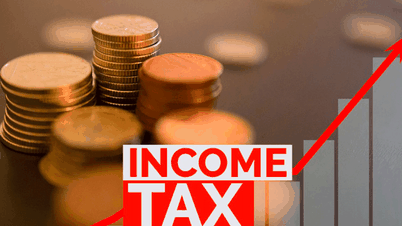
The progressive tax schedule for wage earners currently consists of 7 levels, with tax rates ranging from 5% to 35%. However, the thick tax schedule and the concentration of tax right at the first income steps is an inadequacy that experts have repeatedly suggested to the operator to amend.
Commenting on the draft proposal to build the Personal Income Tax Law (replacement) of the Ministry of Finance , the Thai Nguyen Provincial Tax Department suggested that the drafting agency divide it into more levels, instead of the current 7 levels.
This agency believes that the Ministry of Finance can consider bringing the current tax rates of levels 1, 2, and 3 to lower levels to reduce the burden on taxpayers.
"In reality, with levels 1, 2, 3, taxpayers' income in big cities is only enough to cover living expenses," the Tax Department stated.
Proposed tax adjustment of Thai Nguyen Provincial Tax Department
| Level | Taxable income (million dong) | Current tax (%) | Proposed tax rate (%) |
| 1 | Up to 5 | 5 | 2.5 |
| 2 | Over 5-10 | 10 | 5 |
| 3 | Over 10-18 | 15 | 10 |
| 4 | Over 18-32 | 20 | Similarly, subdivide further |
| 5 | Over 32-52 | 25 | |
| 6 | Over 52-80 | 30 | |
| 7 | Over 80 | 35 |
Also commenting on the tax schedule, the People's Committee of Ninh Thuan province said that the starting tax rate needs to be adjusted to match the current living standards and inflation rate. The progressive tax schedule must also be designed with a reasonable increase, avoiding the burden on people with average incomes, but still ensuring that people with high incomes contribute fairly.
Previously, many experts also suggested improving the tax schedule to reduce the burden on wage earners with income at the top levels. Deputy Director of VEPR Nguyen Quoc Viet proposed reducing it to 5 levels and widening the gap between tax levels.
More specifically, ANVI Law Firm Director Truong Thanh Duc said the tax rate for level 1 should be reduced to about 1-2%; the highest level is 20%. "There is no reason for the personal income tax at level 7 to be 35%, almost double the corporate income tax," Mr. Duc said.
Not to mention, according to Mr. Viet, this helps taxpayers at the first level, especially young workers, have the conditions to accumulate income to invest in improving their own capacity and stabilizing their lives.
"This is a necessary change in the context of increasingly expensive housing prices and service costs directly related to people's lives in big cities," Mr. Viet acknowledged.
This view is also recognized by the authorities. According to the Ministry of Finance, the application of progressive tax rates is common in many countries. Most countries use it to collect taxes at different rates for taxpayer groups with different income levels. This ensures vertical equity in tax policy, that is, the amount of tax payable increases with the increase in income.
The Ministry of Finance cited Indonesia's tax schedule as consisting of five levels with tax rates of 5%, 15%, 25%, 30% and 35%. Similarly, the Philippines has five levels with tax rates of 15%, 20%, 25%, 30% and 35%.
However, the agency acknowledged that the recent general trend is that countries are simplifying their tax schedules by reducing the number of tax rates. For example, some countries such as Malaysia have also reduced the number of tax rates from 11 (in 2021) to 9 (in 2024).
Accordingly, Vietnam can study to adjust the progressive tax schedule in part towards reducing the number of levels and widening the income gap. This is to ensure regulation for high-income earners, making it easier to declare and pay taxes.
VN (according to VnExpress)Source: https://baohaiduong.vn/de-xuat-bac-thap-nhat-cua-thue-thu-nhap-ca-nhan-chi-2-5-405111.html


![[Photo] Keep your warehouse safe in all situations](https://vphoto.vietnam.vn/thumb/1200x675/vietnam/resource/IMAGE/2025/10/1/3eb4eceafe68497989865e7faa4e4d0e)

![[Photo] Hanoi morning of October 1: Prolonged flooding, people wade to work](https://vphoto.vietnam.vn/thumb/1200x675/vietnam/resource/IMAGE/2025/10/1/189be28938e3493fa26b2938efa2059e)

![[Photo] President of the Cuban National Assembly visits President Ho Chi Minh's Mausoleum](https://vphoto.vietnam.vn/thumb/1200x675/vietnam/resource/IMAGE/2025/10/1/39f1142310fc4dae9e3de4fcc9ac2ed0)
























































































Comment (0)